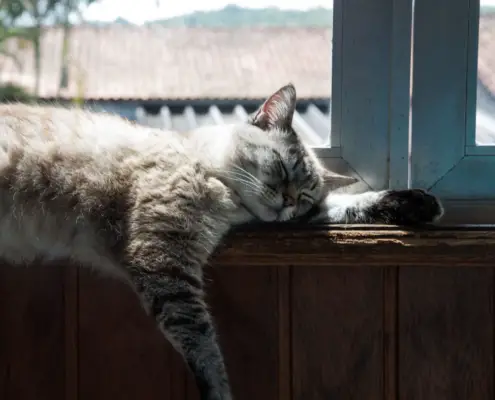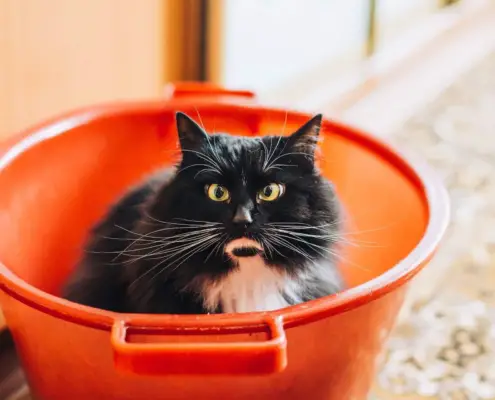
Cats have a unique way of communicating and understanding their behavior is crucial in building a strong bond with them. Unlike dogs, cats are highly independent creatures, and their body language speaks volumes. By paying attention to their cues and signals, you can decipher their emotions and respond accordingly.
When your cat arches its back and raises its fur, it may be feeling threatened or scared. A relaxed and calm cat with ears forward and tail held high indicates contentment. Purring is a positive sign, as it shows your cat is comfortable and happy.
Furthermore, understanding their vocalizations is key. Cats use different meows to convey various messages, such as hunger, affection, or boredom. By paying attention to their body language and vocalizations, you can create a stronger connection with your feline friend.
Building Trust and Establishing a Bond with Your Cat
Building trust is essential for your cat to like you. Trust is earned, and it takes time and patience. Start by respecting your cat’s personal space and allowing them to approach you on their terms. Avoid forcing physical contact if your cat seems uncomfortable or anxious.
To establish a bond, spend quality time with your cat in a calm and relaxed environment. Engage in activities that they enjoy, such as gentle grooming or interactive play sessions. Providing treats and positive reinforcement for desired behaviors can also help strengthen the bond between you and your cat.
Additionally, consistency is key. Stick to a routine that your cat can rely on, including feeding times, playtime, and quiet moments together. By being a reliable and predictable presence in their life, your cat will feel more secure and develop a deeper trust in you.
Creating a Positive and Enriching Environment for Your Cat
Cats thrive in an environment that is stimulating and enriching. Providing them with a variety of toys, scratching posts, and climbing structures can help prevent boredom and destructive behavior. Cats also appreciate having high perches where they can observe their surroundings comfortably.
In addition to physical stimulation, mental exercise is crucial for a cat’s overall well-being. Puzzle toys, treat-dispensing toys, and interactive play sessions can help keep their minds sharp and satisfy their natural hunting instincts.
Creating a safe and comfortable space for your cat is equally important. Ensure they have access to a litter box that is clean and easily accessible. Provide cozy hiding spots where they can retreat when they need some alone time. By creating a positive environment, your cat will feel more at ease and more likely to develop a liking for you.
How to Approach and Interact with Your Cat
Approaching and interacting with your cat in the right way is essential to foster a positive relationship. Cats are sensitive to sudden movements and loud noises, so it’s important to approach them calmly and gently.
When meeting a new cat or approaching your own cat, crouch down to their level and offer a closed hand for them to sniff and investigate. Avoid reaching out to pet them right away, as this can be overwhelming. Instead, let them initiate physical contact by rubbing against you or nudging your hand.
During interactions, be mindful of your cat’s body language and respect their boundaries. If they show signs of discomfort or try to move away, give them space and try again later. By understanding their preferences and adapting your approach, you can ensure positive interactions and gradually build trust.
The Importance of Play and Mental Stimulation for Cats
Play is an essential part of a cat’s life and is crucial for their physical and mental well-being. Engaging in interactive play sessions not only provides exercise but also strengthens the bond between you and your cat.
Using toys that mimic prey, such as feather wands or laser pointers, can tap into their natural hunting instincts. Allow your cat to pounce, chase, and capture the toy, providing them with a sense of achievement and satisfaction.
In addition to play, mental stimulation is equally important. Introducing puzzle toys or hiding treats around the house can keep your cat engaged and prevent boredom. Regularly rotating toys and providing new challenges will keep your cat’s mind sharp and prevent them from becoming disinterested.
Remember, each cat has different preferences, so be observant and adjust your play and mental stimulation activities accordingly. By providing them with outlets for their energy and curiosity, you will not only keep them entertained but also strengthen your bond.
Using Positive Reinforcement to Encourage Desired Behaviors
Positive reinforcement is a powerful tool in training and encouraging desired behaviors in your cat. Rewarding your cat with treats, praise, or playtime when they display behaviors you want to reinforce will motivate them to repeat those behaviors.
For example, if your cat uses their scratching post instead of your furniture, reward them immediately with their favorite treat or engage in playtime with them. This positive association will make them more likely to choose the desired behavior in the future.
Avoid using punishment or negative reinforcement, as it can create fear and resentment in your cat. Instead, focus on positive reinforcement and consistency. With time and patience, your cat will learn to associate your presence with positive experiences and develop a liking for you.
Common Mistakes to Avoid When Trying to Bond with Your Cat
When trying to bond with your cat, there are some common mistakes to avoid that may hinder your progress. Firstly, never force physical contact or overwhelm your cat with too much attention. Let them approach you on their terms, and respect their need for personal space.
Another mistake is neglecting your cat’s needs for mental and physical stimulation. Cats can become bored and frustrated if their environment lacks enrichment. Make sure to provide them with plenty of toys, playtime, and a stimulating environment to keep them happy and engaged.
Additionally, avoid punishing your cat for unwanted behaviors. Instead, focus on redirecting their attention and rewarding desired behaviors. Punishment can lead to fear and anxiety, which can strain your relationship and make your cat less likely to like you.
Patience and Persistence: Building a Relationship Takes Time
Building a strong bond with your cat takes time, patience, and persistence. Each cat is unique and may require a different amount of time to warm up to you. Some cats may be more outgoing and affectionate, while others may be more reserved.
It’s important to understand that trust and love cannot be forced. Be patient with your cat and allow them to set the pace. Respect their boundaries and provide a safe and comforting environment for them to explore and relax.
Consistency is key in building a relationship with your cat. Stick to a routine, provide them with the care and attention they need, and be a reliable presence in their life. Over time, your cat will come to appreciate your efforts and develop a liking for you.
Seeking Professional Help for Challenging Cases
In some cases, building a bond with your cat may prove to be challenging despite your best efforts. If you find that your cat is displaying persistent fearful or aggressive behavior, it may be beneficial to seek professional help.
A veterinarian or animal behaviorist can assess your cat’s behavior and provide guidance on how to address any underlying issues. They may recommend behavior modification techniques, medication, or other interventions to help improve your cat’s well-being and strengthen your relationship.
Remember, seeking professional help is not a sign of failure but rather a proactive step towards creating a loving and harmonious relationship with your cat.
Enjoying a Loving and Harmonious Relationship with Your Cat
By understanding cat behavior, building trust, creating a positive environment, and using positive reinforcement, you can master the art of getting your cat to like you. Remember to be patient, be consistent, and respect your cat’s individuality.
Enjoy the journey of building a relationship with your cat and cherish the moments of love and companionship. With time and effort, you can transform your cat from a foe to a friend and experience the joy of a loving and harmonious bond.
If you enjoyed my article, I would appreciate you sharing it with your network.

Sima Ndlebe
Sima writes for CatBuzz. He is interested in Cats, Health and Fitness, and Entrepreneurship.
Published: 30 October 2023




